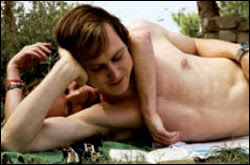The death this past weekend of Robin Wood, one of the greatest and most influential film critics, is being mourned by cinephiles all over the internet. Some of the best tributes come from David Bordwell, Girish Shambu, Dave Kehr and Glenn Kenny. I posted a couple feeble comments of my own at Dave Kehr's blog, in the company of such esteemed critics and friends of Wood as Adrian Martin, Kent Jones, Joseph McBride and Tony Williams. His first book, Hitchcock's Films, probably the first serious book of film criticism I read as a budding cinephile back in 1970, was enormously influential to me and countless others. I no longer have that mass-market version of the book shown above, but I'm beginning to reread my copy of Hitchcock's Films Revisited, a major expansion of the original 1965 book which he published in the late 80s.
I had already been reading and admiring Robin Wood's numerous books (on Hawks, Bergman, Chabrol, Antonioni and the Apu trilogy) and articles for several years in the 70s when I came across his famous 1977 article in Film Comment, Responsibilities of a Gay Film Critic. It was a revelation to me, still closeted at the time, that one could be openly gay and also a serious film critic who shared so many of my tastes in film. The next year I attended a memorable screening of Brian de Palma's SISTERS at which Wood discussed the film, part of a series on horror films called "The American Nightmare."
Wood's always elegant, lucid prose style and his passionate defense of his favorite films are what make his work so eminently rereadable. He was a brilliant mind who, from all accounts, was also a truly decent, generous and caring man.
UPDATE: Jonathan Rosenbaum's list of Robin Wood's Final Top Ten, illustrated with some gorgeous stills, is a fitting tribute.




















































